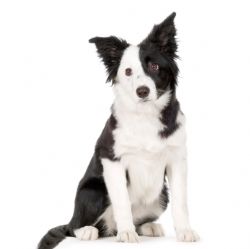Border Collie Dog Breed
Aliases: The Border, the Working Collie, the Farm Collie, the English Collie and the Old-Fashioned Collie
Description
The Border Collie is a well balanced medium-sized athletic dog, bred for working and its intelligence, with either a smooth coat or is of medium length with a thick water resistant undercoat. It rather looks like an Australian Shepherd (without the bob-tail). The muzzle tapers elegantly to the all black nose and its ears are usually half perked.
Long and lean looking with a wide skull, it is extremely intelligent and works hard to please. The Border\'s body is slightly longer than the height at its withers. Their liquid dark brown eyes are oval, with the exception of Merles, and then one or more eyes may be blue. On a well proportioned dog, the teeth should meet in a neat scissors bite - no over bite or underbites. Its lovely flag of a tail is never carried over its back, but is raised when the dog is excited.
Training this dog requires patience due to their high level of energy, but they respond well to obedience work, agility, fly ball, rally-o and other games. The Border\'s main raison d\'etre is herding sheep and their stamina and patience is highly renowned. Known for their hypnotic eye, the Border\'s herding skills are second to none - using eyes only to guide a herd - no nips or barks.
Coat Description
Borders are double coated, with a moderately long, dense, medium textured topcoat. The undercoat is short, soft and dense, offering good weather protection. The luxuriant coat forms the mane, brush and breeching. Usually the face, ear tips, forelegs (except for the feathering), and hind legs from hock to ground, features short and smooth hair. A smooth coat is acceptable. Just about any color of Border (see section below Colors) is acceptable except pure white.
History
The Border hails from the British Isles in the border country of England and Scotland. The derivation of the name Collie seems to be a hot topic, with some saying it comes from the Gaelic word meaning useful. Others insist it came from "coalie" meaning black, and still others say collie was the name of a breed of sheep.
Whatever the case may be, the Border is a very old breed and appears in literature as far back as 1570. It wasn\'t until 1915 that James Reid, the Secretary of the International Sheepdog Society in Great Britain first called the dog a Border Collie. Sheepdog trials were first held in 1873 in Wales and in 1880 in the USA.
Temperament
Highly intelligent with a high instinctive drive to work intensely with a human handler. They are demanding, energetic, busy minded and busy outside and inside (even if they have just been exercised). They are rather like the Arabians of the horse world, high endurance and incredible stamina are the hallmarks of this working dog\'s heritage. In fact they have been bred to run many miles a day over some unimaginable terrain, but yet they get up and do it all over again the next day.
Border\'s are the Type A personalities of the canine world, always wanting to work no matter what the job is - dogs sports or herding. They must have plenty of exercise, no sitting around in a yard or the house for this breed. A workaholic to the core, the Border can become neurotic, destructive and obsessive if it gets bored. Bordeom may manifest itself in the form of heading just about any thing that moves, including bugs, children, cats and brooms.
Sponges for affection and hogs of the lime light, these dogs will watch you intently always winding up underfoot. People-oriented, the Border needs to receive very good socialization as a pup. Older Borders are rather stand offish with people they don\'t know, and can be aggressive with other dogs.
Despite being as intelligent as they are, they mature slowly and seem to be able to manifest "puppy brain" behaviour even into their senior years. So be prepared for the class clown of the herding world. Maturity and dignity don\'t become words used with a Border until they are about 3 - 4 years old.
Thyroid Disease - High Risk
The Border Collie ranks #29 among all breeds for autoimmune thyroiditis prevalence. There is a high risk of obtaining a dog that will develop thyroid disease. For this reason you should make sure you, or your breeder, are testing all dogs before breeding. It may even be a good idea to test dogs that you don't plan on breeding so that any instance of disease can be traced back to breeding pairs and eliminated.
| Rank Among Breeds |
Number of Dogs Tested |
Percent of Dogs With Disease |
| #29 |
2,197 |
11.2% |
You can download the full report (on all breeds) by the Michigan State University Diagnostic Center for Population and Animal Health. Here
Other Health Problems
Generally a quite hardy breed, the Border does have some special medical conditions to be aware of:
- Hip Dysplasia: Canine Hip Dysplasia (CHD) can cause mild to severe lameness.
- Osteochondritis Dissecans: a degenerative disease of the joints, associated with over-nutrition and too-fast growth of puppies.
- Progressive Retinal Atrophy: manifests as night blindness, slowly progresses to total blindness.
- Collie Eye Anomaly: can cause blindness, but is not a progressive disease
- Epilepsy: a neurological seizure disorder. There is no test for this.
- Deafness: Congenital deafness can be a problem.
- Issues with Anaesthetics: Since Borders have such low body fat they may be more sensitive to barbiturate-based anesthetics.

